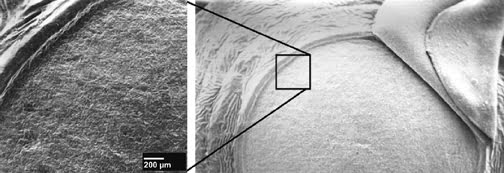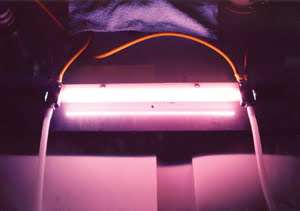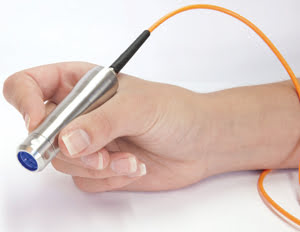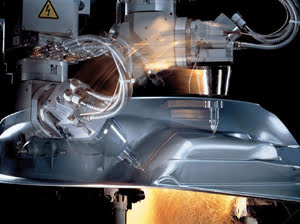Lasers are tools, no more and no less.
They are used to illuminate and to burn, to mark items and to measure them. In many
ways, they are as ubiquitous as knives and tape measures, and they are treated as
common consumer products in many ways. Yet their highly technical nature –
consider the firm grasp of physics required to design them – means that lasers
have a certain amount of mystery and wonderment surrounding them. That they can
be used in products ranging from presentation pointers and home video projectors
to industrial-scale hole drillers and semiconductors scribers adds more power to
their global reputation.
Flexible and efficient
Laser companies report that the most pressure being placed on
laser makers is to make their technologies more powerful and efficient than ever
– but while improving reliability and reducing costs, especially for volume
production.
William Shiner, vice president of industrial markets for IPG Photonics
in Oxford, Mass., said fiber lasers offer both the flexibility and efficiency that
the company’s clients require. IPG’s fiber lasers, he said, provide
30 percent wall-plug efficiency and can be used to cut brass, copper and aluminum
faster than gas lasers can. For added flexibility of design, fiber lasers are good
for long-reach applications, such as welding and cutting.

An electron microscope image shows a corneal incision made with a laser surgical system.
Courtesy of Qioptiq.
Responding to a client’s needs is paramount to most laser
makers. Diode laser makers, for example, must be able to provide, often on very
short notice, devices that produce beams with challenging power levels, wavelengths
and power efficiency, while squeezing into ever-tighter packages. To be successful
going forward, laser manufacturers will have to be strong in customer service and
flexible with their product offerings, said Ian Alcock, managing director of Qioptiq.
IPG Photonics’ Shiner said that efficiency and beam control
are near the top of customer requirements. However, cost control is the overriding
issue.
“We haven’t seen the bottom of prices,” he said.
“Price reductions will have to come through material choices and economies
of scale.”
At JDSU Corp. in Milpitas, Calif., it’s the same story.
“Power and beam quality are in demand,” said Werner Wiechmann, the company’s
director of marketing. “People want just one laser – not 10 separate
ones – to do 10 tasks on wafer jobs.”
Going forward, Wiechmann suggested, the laser market remains fluid.
JDSU, along with other companies, is building more and more single-emitter diode
lasers and squeezing them into systems. Fiber lasers, he said, will expand to shift
the industry much the way that diode-pumped solid-state (DPSS) lasers did a number
of years ago.
Not everyone has given up on dye lasers entirely; they are still
ubiquitous in some niche markets, including astronomy and aesthetic surgery. Most
diode laser makers feature semiconductor devices designed to pump gas lasers, and
improvements in diode lasers are expected to further support dye laser applications.
Robin Elkins, CEO of Elk Industries LLC and chief scientist at
American Advanced Technologies Inc., sees both liquid and solid-state dye lasers
making somewhat of a comeback because of the increased availability and lower cost
of diode lasers.

Flexibility in design may lead to novel laser-based
inventions, such as this “universal” lamp and laser, which uses a single
tube filled with nitrogen, argon or other gas. Courtesy of American Advanced Technologies
Inc.
Applying themselves
The research world will continue to use lasers of all stripes
toward applications in attosecond imaging, solar cell texturing, laser cooling of
atoms, metrology and interferometry, holography and high-powered beam combining
for energy research. For many laser manufacturers, though, the watchword is industry.
“We see opportunities for industrial applications such as
rapid prototyping, laser-based measurement, remote sensing and the continuing development
of biotech applications such as the next-generation DNA sequencers and stem cell
sorters,” said Qioptiq’s Ian Alcock.

The handheld portion of a laser scalpel made by Linos GmbH, now part
of Qioptiq. Courtesy of Qioptiq.
“The beauty is not just in the lasers, but in how you use
them,” added IPG Photonics’ William Shiner, who added that the company
has a lot of product representation in university labs, which in turn provide it
with application development ideas. He also noted that the alternative energy markets
represent a large niche for lasers. For example, the company’s fiber lasers
are used in the production of the batteries being installed in the new generation
of electric cars. Lasers are likewise prominent in the manufacture of wind turbines
and solar panels, and likely will continue to remain so.
JDSU is seeing a strong trend toward micromachining applications,
including wafer semiconductor processing and lasers for drilling silicon and sapphire
substrates used in LED and display technologies, Wiechmann said.
In addition to traditional OEM pumping of industrial lasers, especially
fiber lasers, high-energy science and defense applications will be hallmarks of
the coming year, Dilas’ Joerg Neukum said. DPSS lasers in the 50- to 100-kW
class will grow as these applications continue to require increases in power, brightness
and durability. Challenges in the high-power field remain, however. The output of
each bar in a diode stack must grow into the 500-W to 1-kW range, Neukum said, plus
high-power lasers still haven’t found a “killer app” yet. Additional
government funding will be required to develop techniques and products for such
an unthought-of application, and it’s still at least a couple of years away.

Industrial lasers for welding, cutting and other materials processing are a major strength
for an industry exiting the recent recession. Courtesy of Trumpf.
Neukum said the company also is focused on providing lasers for
computer-to-plate and printer manufacturers – a market that he said disappeared
a couple of years ago but is now coming back. Medical lasers for surgical, ophthalmological
and aesthetic applications also are on the company’s radar for the next year
or more.
New laser technologies may be generated from customer demands
for higher power, more brightness and better beam quality, but new applications
just as likely follow from new technologies. Advancements in beam quality, shorter
pulse widths and increased power at alternative wavelengths, such as ultraviolet
and green, together act as an incubator for novel applications, said Tim Morris,
general manager of Trumpf Inc.’s Laser Technology Center.
“Some recent breakthroughs resulting from (Trumpf’s)
high-power picosecond laser developments are high-volume precision cutting of thin
display glass and nonmetallic stents,” he said.
One of the key technologies to watch in 2011 will be green diode
lasers, said Walter Burgess of Power Technology Inc. of Little Rock, Ark. Applications
for these as part of picoprojection systems will continue to expand, he said, but
their use will grow beyond that because they work well in analytical instruments
also. Diode lasers in the 50-mW region are needed to make cell phone projectors
possible, and they must be highly efficient to be practical. The power requirements
of larger projection systems will be a hindrance, at least for a while longer.
Speaking of analytical instruments, smaller and less costly diode
lasers mean more opportunities to bring miniature spectrometers to the market.
“Customers are asking for handheld portable spectrometers
to take out of the research lab so as to apply them in real-world environments,”
said Eric Bergles, vice president of sales and marketing at BaySpec Inc. in San
Jose, Calif. Compact lasers, miniature spectrographs, increasingly sensitive detectors
and semiconductor nanotechnologies will lead to a “fruitful new generation
of laser-based sensors and instruments,” Bergles said.
Placed in the hands of field agents, smart phone-size spectrometers
will improve inspections of imported foods and other materials, help identify bioweapons
on the battlefield, assist emergency crews with identifying and handling toxic spills,
and make possible on-site inspection of installed solar panels, among many possible
applications.
“There are many new handheld field-deployable spectral engines
entering the market,” Bergles said. “It is the realization of the tricorder.”
Ancillary markets
The market forces affecting laser makers also are affecting the
companies and products supporting them. Advances in optics, coatings and beam profilers,
for example, have had to keep up, and the major players in this field are keeping
a close eye on laser trends.
“The strongest area of growth for us has been the trend
for high-power optics technology to migrate from military applications to commercial
and industrial sectors,” said Nick Traggis, vice president and general manager
of Precision Photonics Corp. in Boulder, Colo. In all, the company’s revenues
grew by 45 percent in 2010 compared with the previous year and, like many laser
companies, Precision Photonics is concerned with retaining and adding qualified
workers in the coming year.
Looking at the laser markets from an optical component perspective,
Traggis sees room for improvement.
“As I talk to more of the end users for [laser] systems,
I realize that too many laser manufacturers still focus on their laser technology
instead of a customer’s problems,” he said. “No matter who the
end user is, Traggis asserts, they have a problem that must be solved, and they
don’t care whether the solution is photonics-based.
“Solution-focused manufacturers will always be more successful;
or, to put it another way, take the word ‘laser’ out of your marketing
material.”